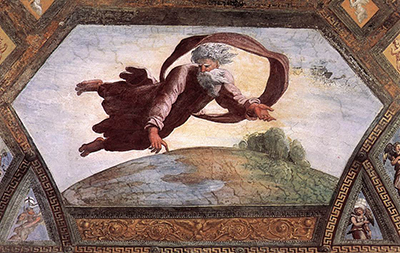Located in the Vatican's Palazzo Apostolico, Raphael's The Separation of Land and Water depicts an airborne supernatural figure - presumably God himself - dressed in flowing, deep red robes and poised above a bucolic depiction of a sparse early incarnation of the Earth.
The sky above the Earth's surface - which serves as a backdrop to the piece - frames the figure in a subtle, warm glow, set against an otherwise lightly clouded vista. White haired and heavily bearded, the figure extends a single finger to touch the Earth's surface at the precise point at which a partially formed sea meets the shore. His eyes gaze carefully towards this point, bright white brows furrowed in concentration as if monitoring an ongoing process. The other hand is outstretched in an open palmed gesture, as if drawing from or projecting some divine power. Beneath this hand, the beginnings of a forest can be seen - perhaps drawn into being in the presence of this energy.
The main image of The Separation of Land and Water is contained in a horizontally elongated hexagonal panel, around which smaller panels depict religious imagery including angels and cupid-like figures, alongside ornately patterned sections. These individual components are brought together elegantly using intricate geometric bands. Intriguingly, the flag of St George is seen twice, in one case flying above a distinctive green land mass located in a small triangular panel to the bottom left of the image, in the other being held aloft by a female figure in a similarly shaped panel in the opposing corner.
In common with all frescos, The Separation of Land and Water would have been painted directly onto a fresh, lime plaster substrate. The resultant paint and lime mix which forms the image - though exceptionally durable - would then be susceptible to a degree of cracking as the material dries. This is offset in the image using detail which - while adding texture and a sense a world in flux to the natural scene depicted - also resembles the aforementioned cracking.
While The Separation of Land and Water - being of course a later example of Raphael's work and therefore created by a team of artisans using the artist's drawings and directions - lacks some of the clarity of Raphael's earlier work, it is nonetheless a seminal example of High Renaissance architectural art. The influence of both Raphael's father Giovanni Santi and close contemporaries da Vinci and Michelangelo shines through, and the manner in which the artist has adapted the style of composition to account for both the method used to create the piece and the decaying nature of its location is remarkable.
In the years directly following Raphael's death, his renown was arguably overshadowed by Michelangelo's somewhat grander, more boldly illuminated creations. However, Raphael's lighter touch and altogether more nuanced, sentimental approach would go on to be a major influence in classical painting from the late 1600s and into the 19th century. All of these attributes are evident in abundance in this timeless and compelling work. See also Michelangelo's Separation of the Earth from the Waters and Separation of Light from Darkness frescoes.




